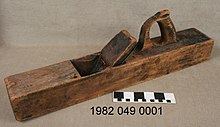 A Stanley #7 jointer plane | |
 Wooden jointer from c.1880 | |
| Other names | Try plane Trying plane Trueing plane[1] |
|---|---|
| Used with | Jack plane and smoothing plane |
The jointer plane, also known as the try plane or trying plane, is a type of hand plane used in woodworking to straighten the edges of boards in the process known as jointing, and to flatten the faces of larger boards.[2] Its long length is designed to 'ride over' the undulations of an uneven surface, skimming off the peaks, gradually creating a flatter surface. In thicknessing or preparing rough stock, the jointer plane is usually preceded by the fore plane or jack plane and followed by the smoothing plane.[2][3]
Jointer planes are typically 20 to 24 inches (510 to 610 mm) long, and are the longest hand planes commonly used.[2] Under the Stanley Bailey numbering system, #7 and #8 planes are jointer planes.[4]
The use of the name jointer plane dates back to at least the 17th century, referring to the process of readying the edges of boards for jointing.[5] The terms try plane, trying plane, and trueing plane have been in use since at least the 19th century.[3]
As with other hand planes, jointer planes were originally made with wooden bodies. But, since the development of the metal-bodied hand plane at the end of the 19th century, wooden-bodied jointers have been largely superseded. Metal-bodied planes are heavier, which is particularly noticeable for planes as large as jointers. This can make metal-bodied jointers more tiring to use for extended periods of time.[6]
- ^ Hasluck, Paul N. (Paul Nooncree) (1907). Cassells' carpentry and joinery. The Library of Congress. Philadelphia, D. McKay.
- ^ a b c Schwarz, Christopher. "Understanding Bench Planes", Popular Woodworking Magazine, 08 October 2008, Retrieved on 22 April 2015
- ^ a b Hasluck, Paul N. (1907). Cassell's Carpentry and Joinery. The Library of Congress. Philadelphia: David McKay. p. 13.
- ^ "Stanely Bailey Planes Miscellaneous Data". primeshop.com. Retrieved 2020-10-09.
- ^ Moxon, Joseph (1703). Mechanick Exercises: or, The Doctrine of Handy-Works Applied to the Arts of Smithing, Joinery, Carpentry, Turning, Bricklayery (3rd ed.). London: Printed for D. Midwinter and T. Leigh... p. 82. hdl:2027/mdp.39015028306002.
- ^ Schwarz, Christopher (2011). The Anarchist's Tool Chest. Fort Mitchell, KY: Lost Art Press LLC. p. 65. ISBN 978-0-578-08413-8. OCLC 875304703.